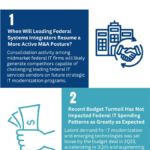Service Providers: IT Modernization Isn’t Flashy, but It Leads to Tangible Savings. Here’s How …
- Up to a 75% reduction in time to introduce new services
- Up to a 99% reduction in time to upgrade or update existing services
- Average total cost of ownership reduction of 10% to 30%
The above are just a few examples of the real-world business outcomes leading service providers are realizing from their IT modernization projects. These outcomes are critical to ensure service providers can adapt and stay competitive in their respective markets as well as grow revenue.
AI, automation, containers, cybersecurity, hybrid cloud, machine learning and virtualization are all examples of the types of technologies service providers are incorporating into their IT modernization initiatives to yield these cost-efficient, flexible and agile outcomes. AI (especially generative AI) is of particular interest of late following technological breakthroughs from OpenAI’s ChatGPT platform, which has demonstrated that generative AI has developed to a point that it is able to bring useful outcomes to businesses and consumers alike.
Generative AI holds tremendous promise for service providers to further improve business outcomes, primarily thanks to the advanced automation the technology can enable. Though generative AI technology is still nascent, it is likely to be incorporated across service providers’ IT estates, from call centers to cybersecurity to billing systems, bringing cost savings, time savings and resource savings.
The outcomes derived from IT modernization become even more important for service providers as they prioritize fiscal responsibility. With high interest rates and a weakening macroeconomic outlook, service providers need to increase their focus on cost efficiencies. Rather than scale back IT modernization initiatives amid fiscal constraints, service providers should double down on these projects because they can help achieve corporate financial objectives.
IT modernization should be thought of as an iterative journey, starting small and expanding the scope over time. Leading service providers that have significant experience with this journey advise that focused prioritization — a step-by-step, iterative approach that tends to require limited upfront financial commitment and ties up fewer resources — is the best approach because the benefits can be rolled into (built upon) next steps in the journey. This contrasts with a boil-the-ocean approach, which typically encompasses a pan-IT estate lift and shift. This approach tends to be risky and expensive and rarely yields the desired results. Another important factor to yield desired outcomes is to ensure the business is aligned with the IT department on every modernization initiative, because when these stakeholders are not in sync, the desired objectives and outcomes are often not realized.
For a closer look at how the key technologies and processes come together to drive telecommunications IT modernization outcomes (AI, machine learning, automation, hybrid cloud, containerization, cybersecurity and more), download “Adapt, compete and grow: A guide to modernizing telco and cable IT.”
To watch a webinar on this topic, “Telecommunications and cable service providers: Modernize IT to adapt, compete and grow,” click here.



 Technology Business Research, Inc.
Technology Business Research, Inc.